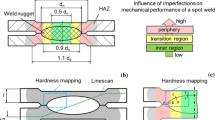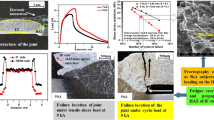Abstract
The development of high-performance automotive steels involves increasingly complex chemistries and heat treating sequences, to produce stronger and lighter parts. To help control the resistance spot weldability of these new alloys, fracture mechanisms that control the weld strength, as well as the crack propagation scenario, must be determined. However, in-situ analysis of spot welds during cross tensile (XT) tests is very difficult due to the configuration of the assembly. This work focused on homogeneous welding of AISI 410-type martensitic stainless steel sheets, using two different welding cycles. The two types of welds failed in partial interfacial failure (PIF) mode but exhibited contrasting XT strength. We used high temperature oxidation of partially fractured spot weld specimens to investigate the 3D crack propagation scenario during XT tests. Measurements of crack front advance and fracture surfaces observations revealed the different steps occurring during PIF. The connection between pop-ins and fracture events was investigated. It was shown that the load–displacement curve was insensitive to significant crack propagation and deviation within the fusion zone (FZ). The method described in the article enabled the comparison of failure scenario of both types of weld. These results highlight the potential of the approach for the investigation of fracture behaviour in contribution to the study of the link between weld microstructure and strength.
















Similar content being viewed by others
Data availability
The data supporting the present findings are not shared because they are part of industrial development.
References
Aghajani H, Pouranvari M (2019a) A pathway to produce strong and tough martensitic stainless steels resistance spot welds. Sci Technol Weld Join 24(3):185–192. https://doi.org/10.1080/13621718.2018.1483065
Aghajani H, Pouranvari M (2019b) Influence of in situ thermal processing strategies on the weldability of martensitic stainless steel Resistance spot welds: effect of second pulse current on the weld microstructure and mechanical properties. Metall Mater Trans A 50:5191–5209. https://doi.org/10.1007/s11661-019-05443-2
American Welding Society (2007) Specification for automotive weld quality: resistance spot welding of steel. AWS, Miami (FL), Standard No. AWS D8.1M:2007
Bhadeshia H, Honeycombe R (2017) Tempering of martensite. Steels: microstructure and properties, 4th edn. Butterworth-Heinemann, Cambridge (MA), pp 237–270
Biro E, Cretteur L, Dupuy T (2012) Higher than expected strengths from dissimilar configuration advanced high strength steel spot welds. Presented at the Sheet Metal Welding Conference XV, Oct 2–5, Livonia, MI
Chen J, Cao R (2017) Micromechanism of cleavage fracture of weld metals. Weld Cutt (china) 2017:55–72
Dancette S (2009) Comportement mécanique des soudures par points : mécanismes et stratégies de prédiction dans le cas des tôles en acier pour automobile. Dissertation, Institut National des Sciences Appliquées de Lyon (France)
Godin H et al (2019) Effects of cooling path and resulting microstructure on the impact toughness of a hot stamping martensitic stainless steel. Mater Sci Eng A 742:597–607. https://doi.org/10.1016/j.msea.2018.11.036
Hernandez VHB, Okita Y, Zhou Y (2012) Second pulse current in resistance spot welded TRIP steels: effects on the microstructure and mechanical behavior. Weld J 91:278s–285s
Hilditch TB, Speer JG, Matlock DK (2007) Effect of susceptibility to interfacial fracture on fatigue properties of spot-welded high strength sheet steel. Mater Des 28:2566–2576. https://doi.org/10.1016/j.matdes.2006.10.019
International Organization for Standardization (2013) Quality requirements for welding: resistance welding of metallic materials—part 2: comprehensive quality requirements. ISO, Geneva, Standard No. ISO 14554–1:2013
International Organization for Standardization (2016) Resistance welding: materials for electrodes and ancillary equipment. ISO, Geneva, Standard No. ISO 5182:2016
Krajcarz F (2013) Quantitative relationships between chemical composition, metallurgical transformations and fracture toughness of the fusion zone of spot welds made of advanced high strength steels. Dissertation, Ecole Nationale Supérieure des Mines de Paris (France)
Krajcarz F, Gourgues-Lorenzon AF, Lucas E, Pineau A (2013) Fracture toughness of the molten zone of resistance spot welds. Int J Fract 181:209–226. https://doi.org/10.1007/s10704-013-9836-1
Lee HS (2012) Diffusion bonding of metal alloys in aerospace and other applications. In: Chaturvedi MC (ed) Welding and Joining of Aerospace Materials. Woodhead, Cambridge (UK), pp 320–344
Lin PC, Pan J (2008a) Closed-form structural stress and stress intensity factor solutions for spot welds under various types of loading conditions. Int J Solids Struct 45:3996–4020. https://doi.org/10.1016/j.ijsolstr.2008.02.006
Lin PC, Pan J (2008b) Closed-form structural stress and stress intensity factor solutions for spot welds in commonly used specimens. Eng Fract Mech 75:5187–5206. https://doi.org/10.1016/j.engfracmech.2008.08.005
Marya M, Gayden XQ (2005) Development of requirements for resistance spot welding DP600 steels—Part 1: the cause of interfacial fracture. Weld J 84:172s–182s
Naït-Oultit B (2008) Endommagement des soudures d'aciers à très haute résistance pendant l'essai de traction en croix : analyse mécanique et métallurgique de la fissuration dans la zone fondue. Dissertation, Ecole Nationale Supérieure des Mines de Saint-Etienne (France)
Nielsen CV, Zhang W, Alves LM, Bay N, Martins PAF (2013) Coupled finite element flow formulation. Modeling of thermo-electro-mechanical manufacturing processes: applications in metal forming and resistance welding. Springer, Dordrecht (NL), pp 11–36
Paveebunvipak K, Uthaisangsuk V (2018) Microstructure based modeling of deformation and failure of spot-welded advanced high strength steels sheets. Mater Des 160:731–751. https://doi.org/10.1016/j.matdes.2018.09.052
Petit T, Ritter C, Besson J, Morgeneyer TF (2018) Impact of machine stiffness on “pop-in” crack propagation instabilities. Eng Fract Mech 202:405–422. https://doi.org/10.1016/j.engfracmech.2018.08.007
Pouranvari M (2017) Fracture toughness of martensitic stainless steel resistance spot welds. Mater Sci Eng A 680:97–107. https://doi.org/10.1016/j.msea.2016.10.088
Pouranvari M, Aghajani H, Ghasemi A (2020) Enhanced mechanical properties of martensitic stainless steels resistance spot welds enabled by in situ rapid tempering. Sci Technol Weld Join 25(2):119–126. https://doi.org/10.1080/13621718.2019.1641962
Radaj D, Sonsino CM, Fricke W (2006) Stress intensity approach for spot-welded and similar lap joints. In: Fatigue assessment of welded joints by local approaches, 2nd edn. Woodhead, Cambridge (UK), pp 433–512
Tumuluru M, Shome M (2015) Resistance spot welding techniques for advanced high-strength steels. In: Welding and joining of advanced high strength steels (AHSS). Woodhead, Cambridge (UK), pp 55–70
Uijl N, Smith S (2006) Resistance spot welding of Advanced High Strength Steels for the automotive industry. In: Proceedings of the 4th international seminar on advances in resistance welding, Nov 14–16, Wels, Austria, pp 30–60
Zhang S (1997) Stress intensities at spot welds. Int J Fract 88:167–185
Zhang S (2001) Fracture mechanics solutions to spot welds. Int J Fract 112:247–274
Zhang XZ, Knott JF (1999) Cleavage fracture in bainitic and martensitic microstructure. Acta Metall 47(12):3483–3495
Zhang H, Senkara J (2006) Weld quality and inspection. Resistance spot welding: fundamentals and applications. Taylor & Francis, Boca Raton, pp 196–228
Funding
This work was supported by the French National Association for Research and Technology (ANRT) under CIFRE Grant No. 2018/0968.
Author information
Authors and Affiliations
Corresponding author
Ethics declarations
Conflict of interest
No potential conflict of interest was reported by the authors.
Additional information
Publisher's Note
Springer Nature remains neutral with regard to jurisdictional claims in published maps and institutional affiliations.
Rights and permissions
About this article
Cite this article
Chanh, C., Gourment, A., Petit, B. et al. Experimental determination of 3D crack propagation scenario in resistance spot welds of a martensitic stainless steel. Int J Fract 235, 215–230 (2022). https://doi.org/10.1007/s10704-022-00626-2
Received:
Accepted:
Published:
Issue Date:
DOI: https://doi.org/10.1007/s10704-022-00626-2




